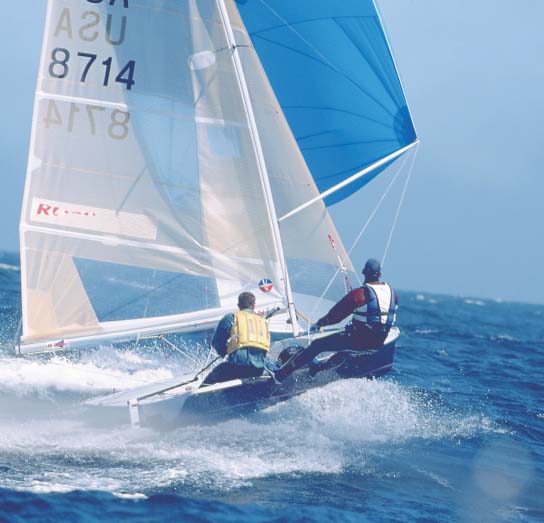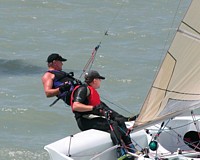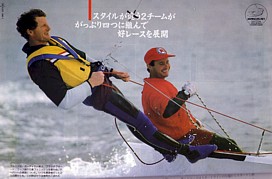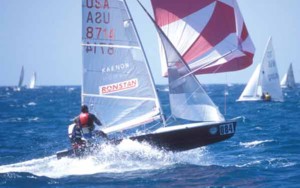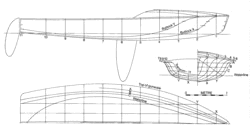|
|
|
The 5-0-5's large spinnaker delivers exciting downwind performance |
The "Five-Oh" has verve! In capable hands she is the most adept of planing boats, easily handling extreme variations of wind and sea, tight maneuvers, and delivering superb performance with sensitive response and surefootedness.
Far ahead of her time, she incorporates major advances in high-performance sailboat design:
- Amazingly, she combines low freeboard with unusual sea-going ability.
- Unlike most planing craft influenced by the International 14 rule, her bow is shaped to eliminate tripping as a cause of capsizing.
- Her bell-shaped hull sections gain lift from the spray and knock it down. Her hull form is slender to ease sea action, yet comfortable seating is provided outboard of the waterline.
- She cannot be out-maneuvered. Her hull profile eliminates turning drag, shortcoupled rudder-centerboard relationship provides immediate response when needed.
- Her brilliantly conceived structural layout places the loads where they can be accommodated ruggedly, yet with minimum weight increase.
- So effective is the design of her emergency flotation, combined with her suction and transom bailers, she readily returns home in severe weather under her own power. Racing officials need provide for collisions or dismasting only in the ruggedest kind of going.
- The large spinnaker, with its unconventionally high hoist and long pole, is unusually easy to use in heavy winds. Her off-winds performance matches her superb on-wind ability whatever the conditions.
- Her large foretriangle base effectively scoops in much air, yet jib area is held to 50% of the mainsail, with little to slow up tacking ability.
The 5-0-5 performs amazingly well in the lightest of air. She slides by the best of them when sailed to advantage, tacks when others fail to complete their tacks, and has a magnificent spinnaker to move her down wind in trying operations. Her unique proportions of long bow, not overly wide waterline beam, low wetted surface and nicely canted "run" let her ghost through a normally harmful wake or left-over sea when others stop dead. The wide side decks permit the crew weight to be spread out so sails can be steadied by sitting well outboard of the bilges. On a drifting reach, the rudder is raised by its inboard control, the board "played" as much as the sails - and she goes, driven by a particularly wellproportioned sail plan that produces a lot of power for its modest area (except the spinnaker, which is far from modest, yet most manageable).
Although she is an unusually good light-weather performer, the 5-0-5 really hits her stride in a gale and rough seas. Here her unique design features make her a special treat, although of course they require thorough understanding so they can be used deftly to develop her full capabilities.
The 5-0-5 has no bad habits to-vex an able skipper. She can blast into a steep, high chop with the best of keel daysailers and ocean racers. Yet she runs off before the same seas without plunging her bow into the waves she overtakes as she dashes off the slope of the one she's leaving behind.
The agile "Five-Oh" has turned at performances such as a 22 minutes' round of a 3.1 nautical mile triangle, including a true beat (average, 8.4 knots); 21/2 minutes flat, covering 0.6 nautical mile on a broad reach (average, 14.4 knots). The close reaches were faster, but recorded separately. These speeds were accomplished in a 1963 sectional championship at Buzzards Bay, Mass. and are representative of the speeds readily attainable with this sailing "sports car."
|
John Westell's 5-0-5 design takes brilliant advantage of freedom from design limitations found in most classes. He chose the largest size that could retain planing dinghy handling characteristics, yet one manageable enough to handle ashore, strong enough to have reasonable structural ruggedness, and still retain lightness.
Mr. Westell kept the after planing portions of the bottom so well developed in the International 14 Class, added a magnificently functional bow where the "14" rule limited itself to a tricky short one. The 5-0-5's bow gives her sail plan a base that neatly absorbs the "butt end" of severe squalls when being driven off the wind, slices the seas when moving into them, yet does not bury itself when dropped down on a wave.
Freeboard has been kept low to reduce wind resistance, but at the same time the usual problems of low freeboard have been solved by the unique flared topsides that shed the seas before they climb on deck. The flare also provides comfortable hiking seats and adds reserve lift from the bow wave when flying along at top speed. There is, in addition, the tremendous enclosed buoyancy of the foredeck, with its high crown for shedding water quickly.
The trapeze increases the pleasure of both skipper and crew. Hiking is more relaxed, more efficient and better controlled. It permits even a very light girl with crewing experience to compete on even terms with a heavy football player. Her agility and fast reflexes can compensate for whatever weight advantage the heavier competition may seem to enjoy. The trapeze also provides a fascinating vantage point from which to observe both the boat and its competition.
In sail plan, the 5-0-5 is again exceptional. It suits the hull capabilities perfectly, aiding sail set and trim under greatly varying conditions. Visibility and maneuverability both spice the give-andtake of close-in tactics. The jib doesn't delay tacking, as it hasn't much overlap, and is easy to sheet in heavy air. While tacking in a "drifter" it doesn't ruin critical airflow by clinging to the mainsail.
The main is twice the area of the jib, proportioned to work well with a spinnaker and designed to take advantage of the bending spar and flexible boom. The boom is controlled by a mid-boom sheet and quick-adjust traveler, and the powerful boom vang can be left in place to assist gibing and off-wind sail trim.
The spinnaker is a radical departure from normal practice. Its halyard runs to a point well above the jib stay, eliminating chance fouling in that area. Its pole is substantially longer than the base of the foretriangle, making the sail far more manageable in a blow and particularly effective in a "dead" run under light conditions. Its overall area is large, yet it is far easier to sail than conventional spinnakers.
|
|
|
That bow can handle any sea. |
"Five-Ohs" are built in Europe, in the US and in Australia. The class numbers some 8800 boats as present. The current (2002) world champion is an Australian, the last one was a german.
The fast, responsive boat develops the best sailor. The 5-0-5 will improve your sailing skills and multiply your enjoyment, whether racing or just sailing a challenging boat for fun.
|
The 5-0-5's efficient cockpit.
|
||||||||||||
|
WHAT THE FIVE-O-FIVE IS HISTORY AND FACTS ABOUT THE ORGANISATION |
